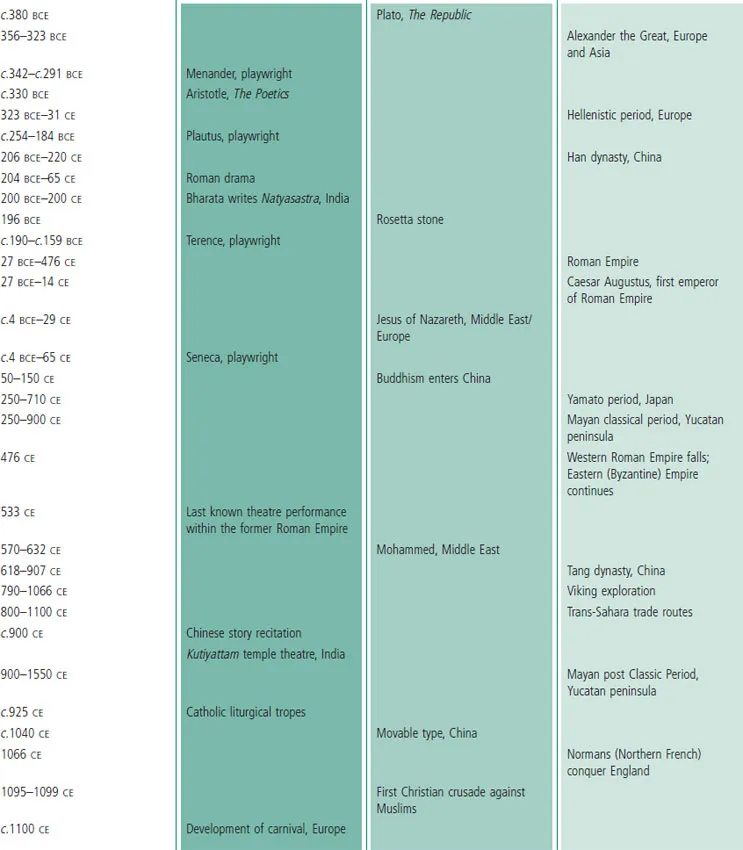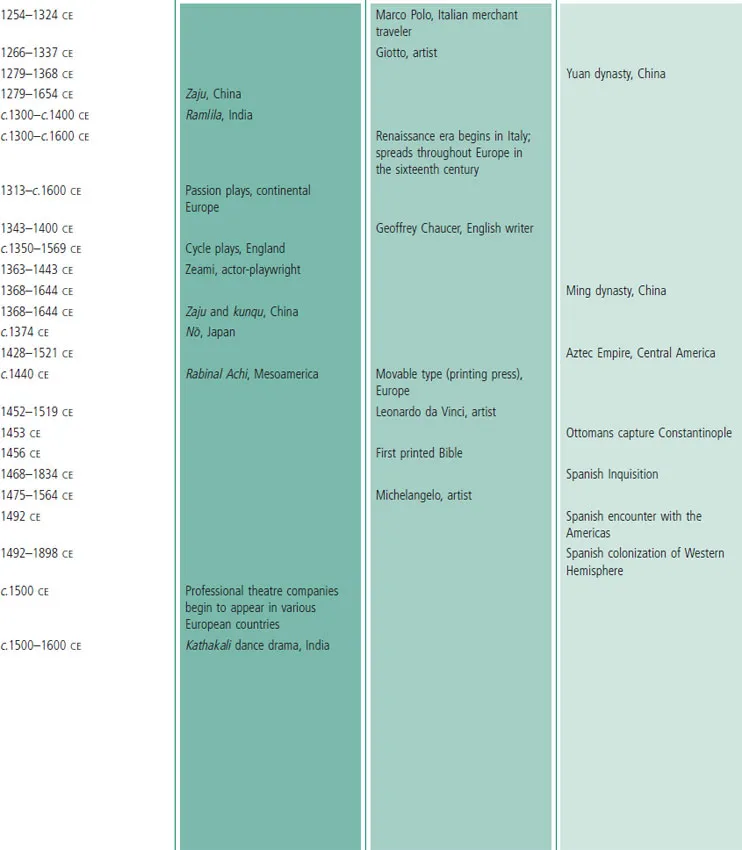![]()
PART I
Performance in oral and manuscript cultures
Part I: Timeline
1 From oral to literate performance
CASE STUDY: Yoruba ritual as “play,” and “contingency” in the ritual process
2 Pleasure, power, and aesthetics: Theatre in early literate societies, 500 BCE–1450 CE
CASE STUDY: Plautus’s plays: What’s so funny?
CASE STUDY: The nō play Dōjōji
3 Commemorative drama and carnival
CASE STUDY: Christians and Moors: Medieval performance in Spain and the New World
CASE STUDY: Playful gods: The Ramlila in north India
Part I: Works cited
PART I TIMELINE
Introduction: Speech, writing, and performance
Tobin Nellhaus
The focus of Part I is the transition from purely oral culture to literate culture. Its three chapters cover roughly 2,000 years of theatre history, from the fifth century BCE to the sixteenth century CE, in order to discuss performance in the context of oral culture and several different literate cultures. The importance and functions of writing varied across the world, and changed over time; as a result, its relationship with oral culture varied, as did its cultural impact. In most of the world, writing’s usage and significance were quite limited. However, due to several unusual circumstances, in the fifth century BCE writing attained widespread importance in the city of Athens, Greece. The repercussions could not have been predicted, but they were vast.
Because of the importance of oral culture, we begin Chapter 1 by considering storytelling and ritual, two primary types of performance for over one hundred millennia before writing even existed. Writing first appeared some time around 3,500 BCE in a region of the Middle East. A few centuries later, hieroglyphic writing developed in Egypt. It was learned by portions of the society’s upper echelons; the culture as a whole remained predominantly oral. As early as the nineteenth century BCE, a mass religious ceremony in Egypt may have had elements characteristic of theatre. Next we leap forward chronologically in order to discuss performance in Central America and southern Mexico, where conditions of literacy were similar to those of ancient Egypt. Some time during the fifteenth century CE, the Mayan people created a performance which commemorated a historical event and appears to have been more like theatre as we know it. We then return to the ancient world to examine the rise of theatre in Athens, where literacy gained a far larger cultural role than ever before. Like Mayan performance, its topics drew from myths and known history, but (perhaps uniquely for the ancient world) it addressed these topics primarily as a way to focus on issues of civic life. In addition, Greek drama was strongly oriented around texts. When classical Greek plays became available in the West again 2,000 years later, they were highly influential, and they are performed even today.
Chapter 2 continues our study of early theatres. Rome in the second and first centuries BCE sought to imitate the culture of Greece, but its tragedies turned from civic commentary to sensationalism, and the comedies shifted from satires toward domestic issues. Eventually interest swung toward violent spectacles such as gladiatorial combat, presented to a mass audience in huge arenas. In classical India (roughly the first through the eleventh centuries CE), theatre was intended to be both popular entertainment and a source of good counsel, and the early plays often drew on two major epics for their narratives. Theatre practitioners in classical India paid exceptional attention to qualities of performance rather than the dramatic text. In the fourteenth century CE, a Japanese troupe offering variety performances came under aristocratic influence and developed a genre of serious drama, which spread across the country. In the course of this development, early Japanese theatre absorbed religious and philosophical ideas. As in India, theatre artists were keenly aware of performance.
The Rosetta stone displays a decree of 196 BCE in three scripts: ancient Egyptian hieroglyphs, Demotic script, and ancient Greek.
Source: © AKG-images, London.
The developments in these diverse parts of the world show the highly varied interactions and combinations of literary work and entertainment on the one hand, and elite and popular performance on the other. Those interactions were rooted in the complex interactions between oral culture and literate culture, which played out differently depending on the particular social circumstances.
In Chapter 3, our attention turns primarily to performance in the context of a significant change in literate culture: the rise of religions founded on a set of holy scriptures. Judaism was based on the Torah; Christianity used the Bible, comprising the Torah as the “Old Testament” and many later texts called the New Testament; and Islam’s holy book was the Qur’an, a work which assumes knowledge of the Jewish and Christian biblical literature but is a separate set of texts. Unlike spiritual documents in other major religions, these books are considered holy in themselves – unalterable, doctrinal, and even thought to be dictated or revealed directly by God. As a result, these texts occupied extraordinary positions within their cultures and played a crucial role in the cultures’ histories. That situation added to the complexity of the relationship between oral culture and literate culture in these societies.
Although the three religions all had a set of holy writings, both literacy and performance developed differently in each. Judaism and early Islam considered literacy part of religious practice, although in some contexts as a support to their oral traditions rather than an independent mode of communication. Jews were an oppressed minority within Europe who had limited opportunities to develop performance practices, but even so, evidence indicates that some Jews acted, and a play was based on a biblical text. Islam reversed its stand on education during the eleventh century and (to a greater or lesser extent) it condemned all representations of people, in theatre and elsewhere; but important types of performance arose nevertheless, such as puppetry. Unlike Judaism and Islam, medieval Christianity had no imperative toward widespread literacy. As in Islam, however, the Church long prohibited theatrical performance. But in the fourteenth century the Church began to find theatre useful, and allowed other types of performance as well. As a result, theatre developed furthest in Christian Europe. Many of the performances within all three religions commemorated events within each religion’s sacred literature, honored major events in the religion’s history, or enacted the religion’s ideas and values. Within Europe there were also important types of wholly secular performance such as farce, and several occasions for boisterous public celebration, feasting, and release, sometimes involving masks and/or role-play.
The prohibition against theatre throughout the history of Islam, for over a millennium in Christianity, and occasionally in Judaism raises a puzzling question: why would a type of performance closely related to the rise of literacy be banned in cultures that depended on writing? The hostility toward theatre was occasionally venomous. For example, a few decades after the medieval Church began encouraging religious drama in England, an unknown author wrote an almost hysterical diatribe against it. It is as though theatre’s adversaries found something fundamentally unnerving and disruptive about acting itself. Theatre was too deeply tied to the body and a notion of personal falsity, and so actors were eventually associated with licentious sex and considered similar to or the same as prostitutes. Such disapproval, which surrounded theatre for much of its existence, seems unfamiliar today.
But this antitheatricality is quite old. In Part I we consider the beginnings of theatre; however, when we speak of the birth of theatre, it’s important to realize that in the Western world, theatre wasn’t an only child: antitheatricality was its sibling. Despite its frequent association with religion, antitheatricality isn’t strictly a matter of faiths and holy books: it arose soon after the creation of literary theatre itself, in a polytheistic culture without scriptures. In ancient Athens, the philosopher Plato (c.428–c.347 BCE), writing at a time when Greek drama was at its height, strongly condemned theatre, along with painting, sculpture, poetry, indeed anything that smelled of what he called mimesis (imitation). In fact, he decried writing as inferior to speech. Yet paradoxically, despite his distrust of writing, Plato wrote books, and stranger still, he wrote his books as dialogues – as near to drama as one can get without actual performance. Most ironically of all, according to classical scholar Eric Havelock (1963), Plato’s antagonism toward theatre arose from the way literacy shaped his concept of rationality. And as Jonas Barish (1981) has shown, these are not the only peculiarities in Plato’s antitheatrical arguments.
Plato’s prosecution of theatre was based on the belief that true reality is to be found in abstractions, not in the embodied material world. From this assumption, Plato staged two fundamental attacks on the stage. On the one hand, philosophically, Plato construed theatre’s fictions as lies, or at best, feeble imitations of the truth. Thus theatre trades in illusions and falsehoods, and the actor in particular violates personal identity by pretending to be someone else. On the other hand, moralistically, if truth resides in abstractions, then the mind as the seat of reason sharply contrasts with the body as the realm of unreason, passion, pleasures, and desires. Theatre, then, wrongly encourages audiences to enjoy unruly emotions and improper ideas instead of conducting rational thought.
Plato’s antitheatrical ideas passed down through the centuries within Christianity, and they may also be the origin of antitheatricality in Islam. To a greater or lesser extent, mimesis was seen as an affront to God. The philosophical and moralistic strands did not always have the same importance – in fact the moralistic stance was usually expressed more vigorously – but they were always intertwined.
But why did Plato’s antitheatrical prejudice arise in the first place, and why did later cultures accept it? Most likely several factors lay behind the sometimes panicky assaults on theatre in the Western world. According to Havelock, one reason for Plato’s animosity is that when writing developed in ancient Greece, it created a break with oral culture and reshaped the reasoning process. Plato was creating an analytical, “objective” mode of thought based on literacy, and opposed to the more “subjective,” participatory oral culture, and mimesis was intrinsic to orality’s participatory nature (1963: 36–49). It appears that not only is there a connection between theatre and writing, there is also a connection between antitheatricality and writing.
Yet as we noted, in Plato’s opinion speech is superior to writing and more closely aligned with truth and nature. At first glance, Plato seems to be contradicting himself, opposing oral culture on one hand but supporting it with the other. However, his opposition was not to all parts of oral culture, but to its embodied, performative element. In contrast, for Plato writing was intrinsically objectionable because the written word is secondary, an imitation (mimesis) of speech sounds – living speech bore truth. The philosopher Jacques Derrida uses the term “phonocentrism” to describe this view of writing as mimetic, and it has persisted even to the present. The logic of phonocentrism, Derrida observes, leads to antitheatricality,...




